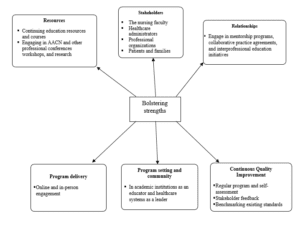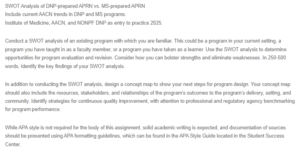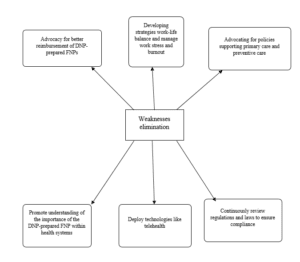SWOT Analysis – DNP-prepared Family Nurse Practitioner
A Doctor of Philosophy-prepared Family Nurse Practitioner (DNP-FNP) is an advanced practice nurse practitioner (APRN) who has completed a Doctor of Nursing Practice (DNP) degree. The APRN role of a Family Nurse Practitioner (FNP) requires completing a master’s education level in nursing and gaining specialized competencies to provide care services to people of all ages. Therefore, FNPs can be found in primary care settings and provide care services to individuals and members of the entire family. MSN-prepared FNPs, due to their education and experience, can work independently or collaboratively with physicians, nurses, and specialists. They also have an expanded scope of practice that allows them to diagnose patients, treat and manage conditions independently, prescribe and administer medications, provide care plans and advice to patients, and work collaboratively, not under the supervision of physicians and specialists (Deering, 2023). A DNP-prepared FNP has more advanced competencies and skills in advanced clinical practice as well as in nursing leadership. The DNP as a terminal nursing degree equips the FNP with skills to develop and implement evidence-based practice with a focus on delivering holistic and patient-focused care (Beeber et al., 2019). DNP-prepared FNPs, compared to MSN-prepared FNPs, have a more advanced understanding of health policies, the policy development process, health systems leadership, and nursing education. They are leaders of entire health systems and work in collaboration with other healthcare professionals and policymakers to develop the right policies that guard the rights of healthcare workers and patients. They also help develop and guide the application of evidence in practice in research. DNP-prepared NPs, other than being in nursing practice, contribute to the nursing faculty, play an essential role in nursing education, and contribute to the development of future nursing professionals.
AACN Trends in DNP and MS Programs
American Association of Colleges of Nursing (AACN) affiliated nursing schools voted on October 25, 2004, in favor of endorsing the Position Statement on the Practice Doctorate in Nursing. The Position Statement on the Practice Doctorate in Nursing aimed to move the current requirements for advancing nursing practice from the master’s degree to the doctorate level (American Association of Colleges of Nursing (AACN), 2023). The National Organization of Nurse Practitioner Faculties (NONPF), on April 20, 2018, also committed to moving all entry-level NP education to the DNP degree by 2025 (National Organization of Nurse Practitioner Faculties (NONPF), 2023). Since then, the AACN (2023) reports that the DNP NP program has been on an upward growth trend and that the last 18 years since its inception has seen the graduation of 72,000 nurses with a DNP degree. DNP NP programs continue to grow rapidly. The NONPF (2023) reports that there were only 125 DNP programs, while in 2021 alone, the DNP NP programs expanded to 254. Additionally, in 2015, there were 934 BSN to DNP graduates and 3327 in 2021 (National Organization of Nurse Practitioner Faculties (NONPF), 2023). Similar trends have been observed in MSN to DNP NP programs. There are 426 DNP programs nationwide, with 70 new DNP programs planned for all states. Between 2021 and 2022 alone, DNP entries grew from 40,834 to 41,021, and graduates increased from 10,086 to 11,149 (American Association of Colleges of Nursing (AACN), 2023).
SWOT Analysis of Moving from MSN-prepared FNP to DNP-prepared Family Nurse Practitioner
This is a SWOT (strengths, weaknesses, opportunities, and threats) analysis for moving from an MSN-prepared FNP to a DNP-prepared FNP.
| Strengths | Weaknesses |
| · Advanced training on clinical skills that make DNP-prepared nurses better than MSN-prepared FNPs
· DNP training FNPs to be a systems leader, which makes them more able to run and manage entire health systems · DNP-FNP provides advanced research and research integration skills, which make the major contributors to improved nursing practice and care delivery · DNP-FNPs have a higher capacity to provide quality patient care using research evidence, which makes them better at patient care than other nurses of lower education levels. |
· DNP-FNPs may work for long hours, which increases the risk of burnout
· Shortage of healthcare professionals and high patient care demand in primary care settings can also increase the pressure on the DNP-prepared FNP and increase the risk of poor work-life balance and burnout |
| Opportunities | Threats |
| · A growing demand for primary care providers creates more opportunities for employment and private practice.
· A better and expanded scope of practice with a DNP degree, creating more work opportunities · Health systems focused on preventative care creating new opportunities for DNP-prepared FNP · New technologies like telemedicine improving service delivery |
· The DNP NP program may take a long time to cover and at higher costs
· The health system’s resistance to change may mean that DNP-FNP and other DNP-prepared nurses may fail to be readily taken up by the system · Unfavorable government regulations that may affect employment and reimbursement levels, making no difference in the earnings of DNP-FNPs and MSN-FNPs · Competition from physicians |
A Concept Map to Bolster Strengths and Eliminate Weaknesses
A Concept Map to Bolster Strengths

A Concept Map to Eliminate Weaknesses
References
American Association of Colleges of Nursing (AACN). (2023). Fact Sheet: The Doctor of Nursing Practice (DNP). American Association of Colleges of Nursing (AACN). https://www.aacnnursing.org/Portals/42/News/Factsheets/DNP-Fact-Sheet.pdf#
Beeber, A. S., Palmer, C., Waldrop, J., Lynn, M. R., & Jones, C. B. (2019). The role of Doctor of Nursing Practice-prepared nurses in practice settings. Nursing Outlook, 67(4), 354–364. https://doi.org/10.1016/J.OUTLOOK.2019.02.006
Deering, M. (2023, October 11). Family Nurse Practitioner Career Overview. Nursejournal.Org. https://nursejournal.org/nurse-practitioner/fnp/
National Organization of Nurse Practitioner Faculties (NONPF). (2023). NONPF Statement – Reaffirming DNP: Entry to Nurse Practitioner Practice by 2025. https://cdn.ymaws.com/www.nonpf.org/resource/resmgr/dnp/04_12_23_reaffirming_the_dnp.pdf
ORDER A PLAGIARISM-FREE PAPER HERE
We’ll write everything from scratch
Question

SWOT Analysis – DNP-prepared Family Nurse Practitioner
SWOT Analysis of DNP-prepared APRN vs. MS-prepared APRN
Include current AACN trends in DNP and MS programs.
Institute of Medicine, AACN, and NONPF DNP as entry to practice 2025.
Conduct a SWOT analysis of an existing program with which you are familiar. This could be a program in your current setting, a program you have taught in as a faculty member, or a program you have taken as a learner. Use the SWOT analysis to determine opportunities for program evaluation and revision. Consider how you can bolster strengths and eliminate weaknesses. In 250-500 words, identify the key findings of your SWOT analysis.
In addition to conducting the SWOT analysis, design a concept map to show your next steps for program design. Your concept map should also include the resources, stakeholders, and relationships of the program’s outcomes to the program’s delivery, setting, and community. Identify strategies for continuous quality improvement, with attention to professional and regulatory agency benchmarking for program performance.
While APA style is not required for the body of this assignment, solid academic writing is expected, and documentation of sources should be presented using APA formatting guidelines, which can be found in the APA Style Guide located in the Student Success Center.


